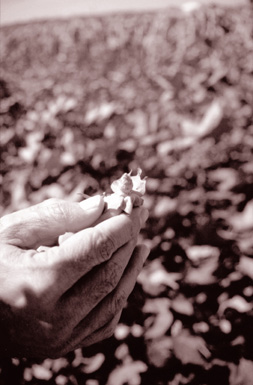|
The
Art
of Precision Agriculture
|
||||
| by Kassidy Aldridge | ||||
|
|
||||
 What
does an orbiting satellite in outer space have to do with your farm? If
you’re involved in precision agriculture, everything. What
does an orbiting satellite in outer space have to do with your farm? If
you’re involved in precision agriculture, everything. Precision agriculture is a technological breakthrough that uses global positioning satellite systems to assist farmers in potentially increasing profits. Many who have heard of this technology are not completely clear about what precision agriculture is or how it helps farmers. Texas Tech University is currently involved in research to further explore the possibilities of this technology. Before choosing to use precision agriculture, farmers must consider how much variability is in their fields. Variability is the variation in a parameter from one part of the field to another. Some factors that exhibit variability are soil fertility, available moisture, pathogens, weeds and insects. Fields with low variability and uniform overall yield will not benefit significantly from the use of precision agriculture. In fields with high variability, the sources of variability must be considered in order to determine if anything can be done to control it. The cost effectiveness of the technology must also be considered when choosing whether or not to implement precision agriculture practices. There are two ways precision agriculture affects profit. One, by increasing yield, and two, by decreasing inputs in areas where they are unneeded. Precision agriculture uses global positioning system technology to locate and plot areas from which samples are taken. This prevents farmers from having to use permanent markers on sampling sites. Samples are sent to a lab to determine soil fertility and other factors. A yield monitor can be used to record yield as the harvester goes through the field, combining with the GPS information to provide locations of high and low yielding areas. Low yielding areas can then be studied to determine the limiting factors. The mapping information obtained using GPS can then be plugged into equipment that applies fertilizer or other chemicals according to the need of the particular area of the field. Weed and insect infestations can also be mapped using this technology and treated accordingly. Because chemicals are only being used in areas where they are needed, the use of inputs likely is more efficient. High yielding areas are not overtreated and low yielding areas can be treated to maximize profits. Depending on the reason for the low production in these areas, farmers may choose to treat or not to treat these areas. In areas where the problem can be attributed to factors that cannot be controlled, many times the farmer may choose to minimize inputs, saving money on inputs that would not be cost effective. Newly developed differential GPS or DGPS allows for much more accurate location mapping, which makes precision agriculture more effective. This is what is most commonly used in precision agriculture today. One research project currently being conducted at Texas Tech, with grants from Cotton, Inc. and the International Cotton Research Center, is studying the relationship between yield variability and variability in soil parameters in two cotton fields. The study uses DGPS to georeference sample sites to enable researchers to study the same sites year after year. Cary Green, assistant professor of soil chemistry at Texas Tech said that in all actuality, precision agriculture may cause variability to increase in a field, with high yielding areas becoming more productive and low yielding areas becoming less productive, but since inputs are being concentrated in areas where they will be most effective, the methods should increase production efficiency. Green said there has not been very much research done on the economics of using precision agriculture methods on cotton because it has taken some time to develop a commercially available yield monitor. The research being conducted now at Texas Tech should provide some insight into the economic feasibility of using precision agriculture in the cotton industry. In the Midwest, some farmers have found they do not see enough increase in production to justify the cost of using precision agriculture methods, but in Texas, not as much research has been done. However, ongoing research being conducted by Texas Tech as well as the Texas Agricultural Experiment Station should help provide answers to this and other concerns in the near future. |
||||